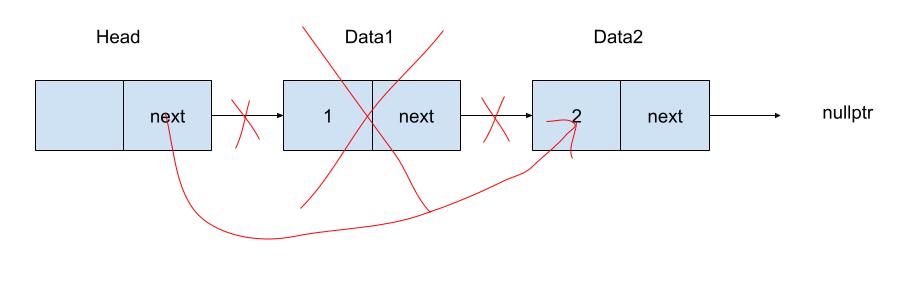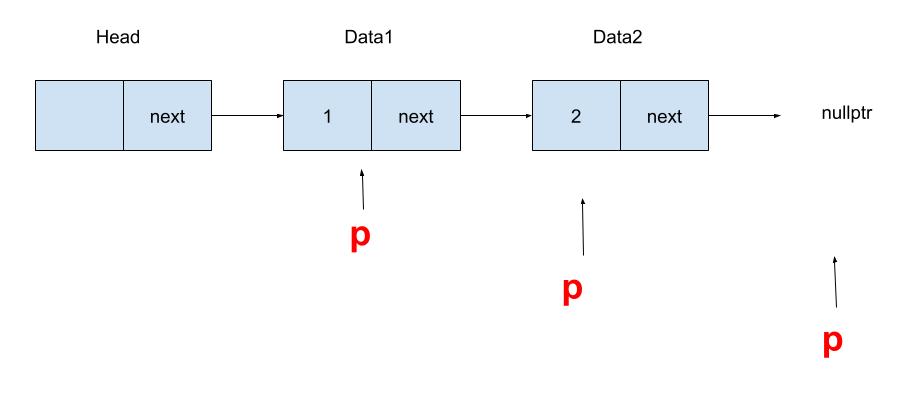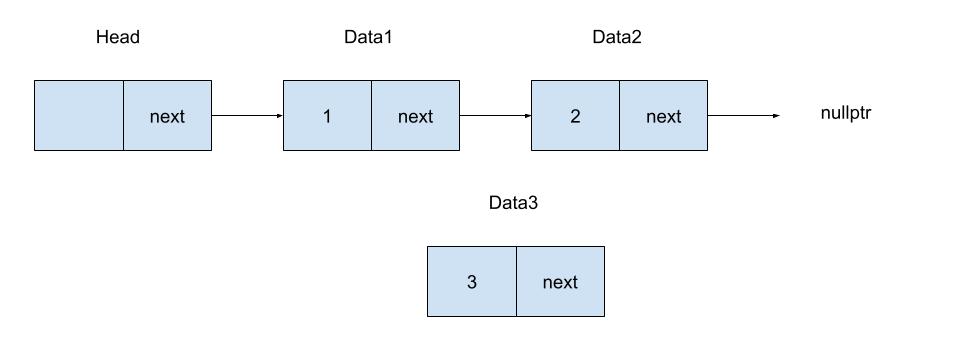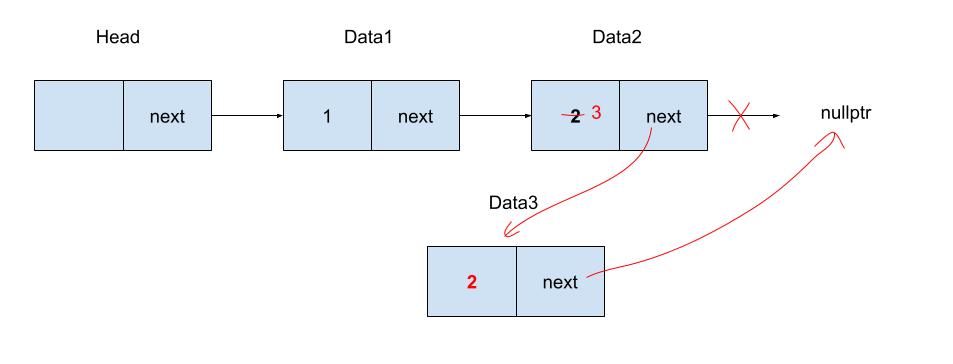單向鏈結串列實作
頭節點
頭節點是沒有值,頭節點的next指向的是第一個節點,最後一個節點的next指向nullptr

結構定義
節點有二個欄位,分別是data與next,data是存放值,next是指向下一個節點
1
2
3
4
5
6
typedef int ElemType;
//定義節點
struct Node {
ElemType data;
Node* next;
};
初始化
初始化判斷頭節點(head)記憶體位址有沒有建立成功
將頭節點(head)的next(下一個節點位址)設為nullptr
返回頭節點的記憶體位址(使用指標傳回),new動態分配記憶體位址,會傳回位址,需要用指標來接。
在main()中建立頭節點
1
2
3
4
5
6
7
8
9
10
11
12
13
14
15
16
/**
初始化鏈結串列
*/
Node* initLinkedList() {
//頭節點
Node* head = new (std::nothrow)Node;
//頭節點記憶體分配失敗
if(head == nullptr) return nullptr;
head->next = nullptr;//下一個節點是null
return head;
}
int main() {
//建立頭節點
Node* head = initLinkedList();
return 0;
}
刪除鏈結串列
刪除所有鏈結串列,包含頭節點(head)
參數是頭節點(head)記憶體位址
繞行所有節點,先把下一個節點存到暫存節點,再刪掉頭節點,再把暫存節點設為頭節點,如此反覆進行,直至下一個節點為nullptr設到head,離開迴圈。
1
2
3
4
5
6
7
8
9
10
11
12
13
14
15
16
17
18
19
20
21
22
23
24
25
26
/**
鏈結串列記憶體回收
參數為頭節點
*/
void destroyLinkedList(Node* head){
if(head == nullptr) {
cout << "鏈結串列不存在" << endl;
return;
}
Node *temp; //暫存節點
//繞行鏈結串列
while(head != nullptr) {
//先把下一個節點存起來
temp = head->next;
//刪掉目前的節點
delete head;
//把剛才存下來的節點作為頭節點
head = temp;
}
}
int main() {
//建立頭節點
Node* head = initLinkedList();
destroyLinkedList(head);
return 0;
}
新增在最前面
有一個資料要新增在最前面

頭節點的next指向新節點,新節點的next指向原本的第一個節點

1
2
3
4
5
6
7
8
9
10
11
12
13
14
15
16
17
18
19
20
21
22
23
24
25
26
27
28
29
30
31
32
bool addFirst(Node* head, const ElemType& ee) {
if(head == nullptr) {
cout << "鏈結串列不存在" << endl;
return false;
}
//建立新節點
Node* temp = new (std::nothrow)Node;
if(temp == nullptr) return false;
//新節點設定傳進來的資料
temp->data = ee;
//新節點的下一個節點是頭節點的下一個
temp->next = head->next;
//頭節點的下一個是新節點
head->next = temp;
return true;
}
int main() {
//建立頭節點
Node* head = initLinkedList();
//增加節點
addFirst(head, 1);
//增加節點
addFirst(head, 2);
//增加節點
addFirst(head, 3);
//增加節點
addFirst(head, 4);
destroyLinkedList(head);
return 0;
}
新增在最後面
要將3的資料新增在最後面

新增步驟如下
- 先移動到最後一個節點(不是nullptr)
- 建立新節點,將新節點的next設為nullptr
- 尾節點的next設為新節點

1
2
3
4
5
6
7
8
9
10
11
12
13
14
15
16
17
18
19
20
21
22
23
24
25
bool addLast(Node* head, const ElemType& e) {
if(head == nullptr) {
cout << "鏈結不存在" << endl;
return false;
}
//先找到尾節點
Node *p = head;
//判斷節點的下一個是否是null
while(p->next != nullptr) {
p = p->next;
}
//建立新節點
Node* temp = new (std::nothrow)Node;
if(temp == nullptr) return false;
//新節點設定傳進來的資料
temp->data = e;
//新節點的下一個節點是null
temp->next = nullptr;
//尾節點的下一個是新節點
p->next = temp;
return true;
}
刪除最前面
把頭節點(head)的next指向要刪除節點的下一個節點

1
2
3
4
5
6
7
8
9
10
11
12
13
14
15
16
17
18
bool removeFirst(Node* head) {
if(head == nullptr) {
cout << "鏈結串列不存在" << endl;
return false;
}
//只有頭節點,沒有後面的資料
if(head->next == nullptr) {
cout << "沒有任何節點" << endl;
return false;
}
//不包含頭節點,取得頭節點的下一個
Node* p = head->next;
//頭節點的下一個是 p的下一個
head->next = p->next;
//把p刪掉
delete p;
return true;
}
刪除最後一個節點
要刪除最後一個節點,要先找到倒數第二個節點。 把倒數第二個節點的next指向nullptr

1
2
3
4
5
6
7
8
9
10
11
12
13
14
15
16
17
18
19
20
21
22
23
24
25
26
27
/**
刪除最後一個節點
參數頭節點
*/
bool removeLast(Node* head) {
if(head == nullptr) {
cout << "鏈結不存在" << endl;
return false;
}
Node *p = head;
//判斷是不是至少有一個節點
if(head->next == nullptr){
cout << "鏈結沒結點" << endl;
return false;
}
//先找到倒數第二個節點
while(p->next->next != nullptr) {
p = p->next;
}
//刪掉最後一個節點
delete p->next;
//把倒數第二個節點作為最後一個節點
//下一個節點為null
p->next = nullptr;
return true;
}
印出所有節點
因為頭節點head是沒有資料,所以一開始是把p指標指向head的下一個節點。

然後將p指標一直往next移動,直至指到nullptr。
1
2
3
4
5
6
7
8
9
10
11
12
13
14
15
16
17
18
19
20
21
22
23
24
25
26
27
28
29
30
31
void printList(const Node* head) {
if(head == nullptr) {
cout << "鏈結串列不存在" << endl;
return;
}
//從head的下一個節點開始
//head不存在值
Node *p = head->next;
while(p != nullptr) {
cout << p->data << ",";
//節點p換成下一個節點
p = p->next;
}
cout << endl;
}
int main() {
//建立頭節點
Node* head = initLinkedList();
//增加節點
addFirst(head, 1);
//增加節點
addFirst(head, 2);
//增加節點
addFirst(head, 3);
//增加節點
addFirst(head, 4);
//印出所有節點
printList(head);
destroyLinkedList(head);
return 0;
}
新增節點在某個節點之前
Data3要新增Data2前面

破解傳統的方式,傳統的方式是用迴圈繞行鏈結串列,找到下一個節點是Data2,才把Data3插進去,新的方式如下:
步驟如下
- Data2的值拷貝到新節點Data3
- 新節點Data3的next設為Data2的next
- Data2的next設為Data3
- Data2的值設成新的資料內容

1
2
3
4
5
6
7
8
9
10
11
12
13
14
15
16
17
18
19
20
21
22
23
24
/**
在某個節點前插入元素
參數Node* node 某個節點前
參數ElemType& e 插入元素
*/
bool insert(Node* node, const ElemType& e) {
if(node == nullptr) {
cout << "節點不存在" << endl;
return false;
}
//建立新節點
Node* new_node = new Node;
//將節點的資料複製到新節點
new_node->data = node->data;
new_node->next = node->next;
//把節點的內容改成新的內容
node->data = e;
//下一個節點指向新節點
node->next = new_node;
return true;
}
刪除某個節點

因為節點不知道上一個節點是那個? 所以採用以下作法
- 把下一個節點的值複製在要刪除的節點
- 把要刪除的節點的next指向下一個節點的next
- 把下一個節點刪除

但要刪除的節點沒下一個節點的話,使用刪除最後一個節點的函式
1
2
3
4
5
6
7
8
9
10
11
12
13
14
15
16
17
18
19
20
21
22
23
24
/**
將節點刪除
*/
bool deleteNode(Node* node) {
if(node == nullptr) {
cout << "節點不存在" << endl;
return false;
}
//若節點為最後一個節點
if(node->next == nullptr) {
//使用其它函式removeLast()
cout << "要刪除的節點是最後一個節點,請使用removeLast()" << endl;
return false;
}
//取得後面節點
Node* after = node->next;
//將後面的節點資料,複製到要刪除的節點中
node->data = after->data;
node->next = after->next;
//把後面的節點刪除
delete after;
return true;
}
取得鏈結串列長度
大小不包含頭節點(head),將鏈結串列繞行一遍就會知道有多少節點。
1
2
3
4
5
6
7
8
9
10
11
12
13
14
15
16
17
18
size_t size(Node* head) {
if(head == nullptr) {
cout << "鏈結串列不存在" << endl;
return 0;
}
//不包含頭節點
Node* p = head->next;
size_t size = 0;
//繞行到null
while(p != nullptr) {
p = p->next;
size++;
}
return size;
//遞迴方式
//if(head == nullptr) return 0;
//return size(head->next) + 1;
}
取得某個節點
1
2
3
4
5
6
7
8
9
10
11
12
Node* getNode(const Node* head, const ElemType& e) {
Node* p = head->next;//排除頭節點,從第1個節點開始繞
while(p != nullptr) {
//如果節點的資料與參數e相同,傳回節點
if(p->data == e) return p;
//移到下一個節點
p = p->next;
}
//最後的是nullptr
//返回nullptr
return p;
}
完整程式碼
1
2
3
4
5
6
7
8
9
10
11
12
13
14
15
16
17
18
19
20
21
22
23
24
25
26
27
28
29
30
31
32
33
34
35
36
37
38
39
40
41
42
43
44
45
46
47
48
49
50
51
52
53
54
55
56
57
58
59
60
61
62
63
64
65
66
67
68
69
70
71
72
73
74
75
76
77
78
79
80
81
82
83
84
85
86
87
88
89
90
91
92
93
94
95
96
97
98
99
100
101
102
103
104
105
106
107
108
109
110
111
112
113
114
115
116
117
118
119
120
121
122
123
124
125
126
127
128
129
130
131
132
133
134
135
136
137
138
139
140
141
142
143
144
145
146
147
148
149
150
151
152
153
154
155
156
157
158
159
160
161
162
163
164
165
166
167
168
169
170
171
172
173
174
175
176
177
178
179
180
181
182
183
184
185
186
187
188
189
190
191
192
193
194
195
196
197
198
199
200
201
202
203
204
205
206
207
208
209
210
211
212
213
214
215
216
217
218
219
220
221
222
223
224
225
226
227
228
229
230
231
232
233
234
235
236
237
238
239
240
241
242
243
244
245
246
247
248
249
250
251
252
253
254
255
256
257
258
259
260
261
262
263
264
265
266
267
268
269
270
271
272
273
274
275
276
277
278
279
280
281
282
283
284
285
286
287
288
289
290
291
292
293
294
295
296
297
298
299
300
301
302
303
304
typedef int ElemType;
//定義節點
struct Node {
ElemType data;
Node* next;
};
/**
初始化鏈結串列
*/
Node* initLinkedList() {
//頭節點
Node* head = new (std::nothrow)Node;
//頭節點記憶體分配失敗
if(head == nullptr) return nullptr;
head->next = nullptr;//下一個節點是null
return head;
}
/**
鏈結串列記憶體回收
參數為頭節點
*/
void destroyLinkedList(Node* head){
if(head == nullptr) {
cout << "鏈結串列不存在" << endl;
return;
}
Node *temp; //暫存節點
//繞行鏈結串列
while(head != nullptr) {
//先把下一個節點存起來
temp = head->next;
//刪掉目前的節點
delete head;
//把剛才存下來的節點作為頭節點
head = temp;
}
}
bool addFirst(Node* head, const ElemType& ee) {
if(head == nullptr) {
cout << "鏈結串列不存在" << endl;
return false;
}
//建立新節點
Node* temp = new (std::nothrow)Node;
if(temp == nullptr) return false;
//新節點設定傳進來的資料
temp->data = ee;
//新節點的下一個節點是頭節點的下一個
temp->next = head->next;
//頭節點的下一個是新節點
head->next = temp;
return true;
}
bool addLast(Node* head, const ElemType& e) {
if(head == nullptr) {
cout << "鏈結不存在" << endl;
return false;
}
//先找到尾節點
Node *p = head;
//判斷節點的下一個是否是null
while(p->next != nullptr) {
p = p->next;
}
//建立新節點
Node* temp = new (std::nothrow)Node;
if(temp == nullptr) return false;
//新節點設定傳進來的資料
temp->data = e;
//新節點的下一個節點是null
temp->next = nullptr;
//尾節點的下一個是新節點
p->next = temp;
return true;
}
/**
在某個節點前插入元素
參數Node* node 某個節點前
參數ElemType& e 插入元素
*/
bool insert(Node* node, const ElemType& e) {
if(node == nullptr) {
cout << "節點不存在" << endl;
return false;
}
//建立新節點
Node* new_node = new Node;
//將節點的資料複製到新節點
new_node->data = node->data;
new_node->next = node->next;
//把節點的內容改成新的內容
node->data = e;
//下一個節點指向新節點
node->next = new_node;
return true;
}
/**
將節點刪除
*/
bool deleteNode(Node* node) {
if(node == nullptr) {
cout << "節點不存在" << endl;
return false;
}
//若節點為最後一個節點
if(node->next == nullptr) {
//使用其它函式removeLast()
cout << "要刪除的節點是最後一個節點,請使用removeLast()" << endl;
return false;
}
//取得後面節點
Node* after = node->next;
//將後面的節點資料,複製到要刪除的節點中
node->data = after->data;
node->next = after->next;
//把後面的節點刪除
delete after;
return true;
}
Node* getNode(const Node* head, const ElemType& e) {
Node* p = head->next;//排除頭節點,從第1個節點開始繞
while(p != nullptr) {
//如果節點的資料與參數e相同,傳回節點
if(p->data == e) return p;
//移到下一個節點
p = p->next;
}
//最後的是nullptr
//返回nullptr
return p;
}
void printList(const Node* head) {
if(head == nullptr) {
cout << "鏈結串列不存在" << endl;
return;
}
//從head的下一個節點開始
//head不存在值
Node *p = head->next;
while(p != nullptr) {
cout << p->data << ",";
//節點p換成下一個節點
p = p->next;
}
cout << endl;
}
size_t size(Node* head) {
if(head == nullptr) {
cout << "鏈結串列不存在" << endl;
return 0;
}
//不包含頭節點
Node* p = head->next;
size_t size = 0;
//繞行到null
while(p != nullptr) {
p = p->next;
size++;
}
return size;
//遞迴方式
//if(head == nullptr) return 0;
//return size(head->next) + 1;
}
bool removeFirst(Node* head) {
if(head == nullptr) {
cout << "鏈結串列不存在" << endl;
return false;
}
//只有頭節點,沒有後面的資料
if(head->next == nullptr) {
cout << "沒有任何節點" << endl;
return false;
}
//不包含頭節點,取得頭節點的下一個
Node* p = head->next;
//頭節點的下一個是 p的下一個
head->next = p->next;
//把p刪掉
delete p;
return true;
}
/**
刪除鏈結串列,但頭節點不刪除
*/
void clearList(Node* head) {
if(head == nullptr) {
cout << "鏈結串列不存在" << endl;
return;
}
//不包含頭節點,頭節點下一個節點不存在
if(head->next == nullptr) {
cout << "鏈結串列沒有節點" << endl;
return;
}
Node* temp1;
//從下一個節點開始刪,頭節點要保留
Node* temp2 = head->next;
while(temp2 != nullptr) {
//下一個節點先丟到temp1
temp1 = temp2->next;
//刪掉temp2
delete temp2;
//temp2變成下一個節點
temp2 = temp1;
}
head->next = nullptr;
}
/**
刪除最後一個節點
參數頭節點
*/
bool removeLast(Node* head) {
if(head == nullptr) {
cout << "鏈結不存在" << endl;
return false;
}
Node *p = head;
//判斷是不是至少有一個節點
if(head->next == nullptr){
cout << "鏈結沒結點" << endl;
return false;
}
//先找到倒數第二個節點
while(p->next->next != nullptr) {
p = p->next;
}
//刪掉最後一個節點
delete p->next;
//把倒數第二個節點作為最後一個節點
//下一個節點為null
p->next = nullptr;
return true;
}
int main() {
//建立頭節點
Node* head = initLinkedList();
//增加節點
addFirst(head, 1);
//增加節點
addFirst(head, 2);
//增加節點
addFirst(head, 3);
//增加節點
addFirst(head, 4);
//印出所有節點
printList(head);
cout << "--------------" << endl;
//增加節點
addLast(head, 5);
//增加節點
addLast(head, 6);
//增加節點
addLast(head, 7);
//增加節點
addLast(head, 8);
//印出所有節點
printList(head);
cout << "size = " << size(head) << endl;
cout << "--------------" << endl;
//取得資料為"5"的節點
Node* node = getNode(head, 5);
//在資料為"5"的節點之前,新增54
insert(node, 54);
//印出所有節點
printList(head);
//刪除54節點
deleteNode(getNode(head, 54));
//印出所有節點
printList(head);
//刪除第一個節點
removeFirst(head);
//印出所有節點
printList(head);
//刪除最後一個節點
removeLast(head);
//印出所有節點
printList(head);
//清空所有節點,(不包含頭節點)
clearList(head);
//釋放記憶體(包含頭節點)
destroyLinkedList(head);
return 0;
}